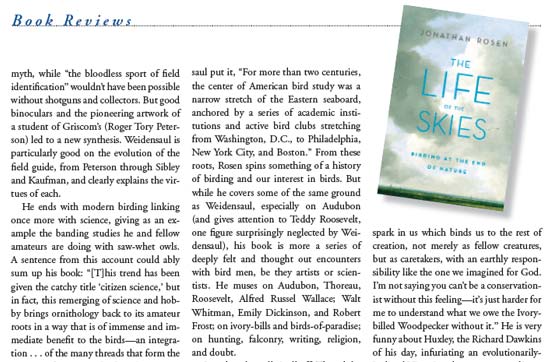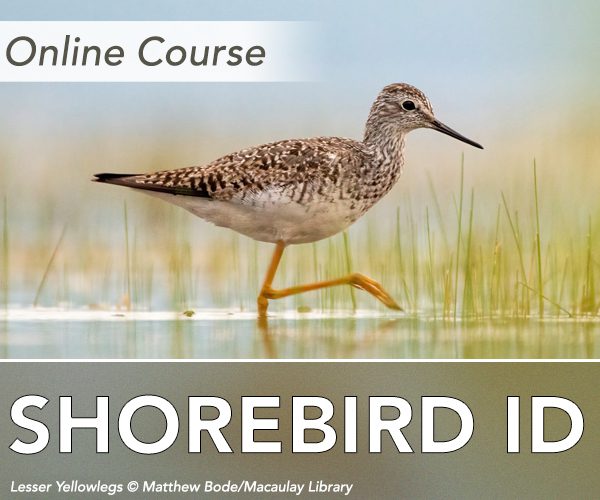The Life of the Skies, by Jonathan Rosen
Reviewed by Stephen J. Bodio January 15, 2008
If Scott Weidensaul loves the science of birding, Jonathan Rosen fell in love with its soul. The Life of the Skies is a love letter to birding by a city boy, a lifelong New Yorker, who was almost religiously stricken when he overheard a stranger say, “The warblers will be coming through Central Park soon.” He writes: “Somehow, for reasons I still can’t explain, I knew right then that even though I wasn’t sure what warblers were, I was going to go and find them.”
While his travels would ultimately take him as far afield as Israel and (in his reading of Wallace) the Malay Archipelago, New York actually isn’t a bad place to start birding. Not only do you have Central Park; you have American birding’s oldest “infrastructure.” New York was Audubon’s last perch, home to the American Museum of Natural History, Teddy Roosevelt, and the place where a young Roger Tory Peterson honed his skills. Or as Weidensaul put it, “For more than two centuries, the center of American bird study was a narrow stretch of the Eastern seaboard, anchored by a series of academic institutions and active bird clubs stretching from Washington, D.C., to Philadelphia, New York City, and Boston.” From these roots, Rosen spins something of a history of birding and our interest in birds. But while he covers some of the same ground as Weidensaul, especially on Audubon (and gives attention to Teddy Roosevelt, one figure surprisingly neglected by Wei- densaul), his book is more a series of deeply felt and thought out encounters with bird men, be they artists or scientists. He muses on Audubon, Thoreau, Roosevelt, Alfred Russel Wallace; Walt Whitman, Emily Dickinson, and Robert Frost; on ivory-bills and birds-of-paradise; on hunting, falconry, writing, religion, and doubt.
Somehow he pulls it all off. Though he has never been a hunter himself, he understands both birding’s cognitive links with hunting and hunting’s virtues: “I’ve only grown more aware of the role of hunters and fishermen—who helped create the wildlife refuge system in which the ivory- bill seems to have survived. It was a shock to discover that wildlife management areas were managed so that people could shoot the wildlife. But it was bracing and somehow liberating, because it altered a definition of human nature that seemed truer, if less flattering, than the one I was used to.” He shows similar feelings toward Roosevelt, noting that “it is important to know that the president who shot the most animals was, perhaps, the one who saved the most as well.”
He is also—unusual among modern “nature” writers (a label which makes him, and me, uncomfortable)—religious. He is perfectly comfortable with evolutionary biology (and very good on Wallace, who was also something of a believer) but looks at some things from a unique angle. “Personally, I believe that there is a divine spark in us which binds us to the rest of creation, not merely as fellow creatures, but as caretakers, with an earthly responsibility like the one we imagined for God. I’m not saying you can’t be a conservationist without this feeling—it’s just harder for me to understand what we owe the Ivory- billed Woodpecker without it.” He is very funny about Huxley, the Richard Dawkins of his day, infuriating an evolutionarily- inclined Victorian clergyman-naturalist so badly that it took 33 years for him to acknowledge Darwin as “our great master.”
The Life of the Skies has a few minor flaws, mostly in editing. Roosevelt’s statue in front of the American Museum is flanked by an African and an Indian—not two Indians; the Hall of African Mammals was constructed by Carl Akeley, not “Conrad Aikley.” Why must I tell a New Yorker this? But like Weidensaul, I grew up as a science kid, and people like these were my mentors. Converts often bring both enthusiasm and new perspectives.
His greatest insight is that even a “diminished thing” can have magic, and intimations of infinity. At the end, he brings Wallace’s grail and the quest for the ivory- bill back home to Tanner’s Spring in Central Park. “Tanner’s Spring is the merest echo of the Big Woods of Arkansas. But the Big Woods of Arkansas are themselves the merest echo of what they used to be. And they are all still connected. Just as backyard birds are in fact birds of paradise. It just depends on your definition of backyard—and paradise.”

All About Birds
is a free resource
Available for everyone,
funded by donors like you
American Kestrel by Blair Dudeck / Macaulay Library

